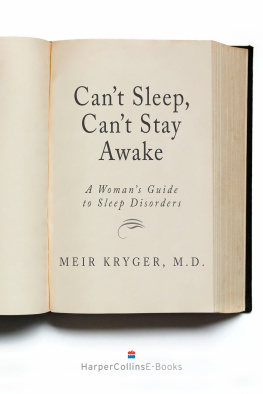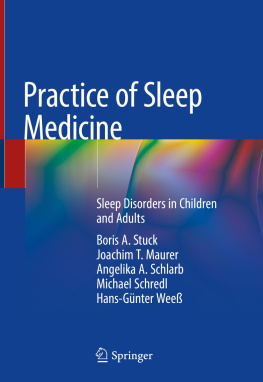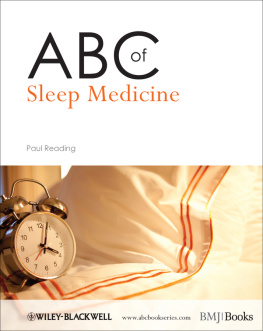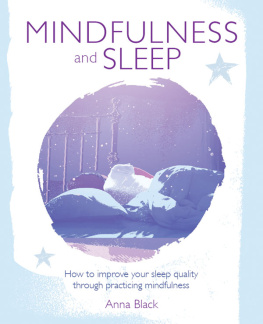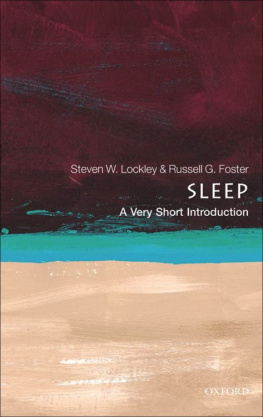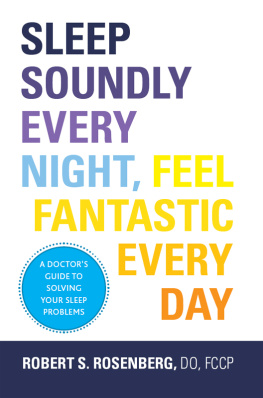
Cant Sleep,
Cant Stay Awake
A Womans Guide to Sleep Disorders
Meir Kryger, M.D.
Past President,
American Academy of Sleep Medicine
Foreword by Barbara Phillips, M.D., M.S.P.H.
Introduction by Richard Gelula, M.S.W.,
CEO, National Sleep Foundation

This book is dedicated to my wife, Barbara,
and my children, Shelley, Michael, and Steven.
Contents
by Barbara Phillips
M eir Kryger literally wrote the book about sleep medicine. He is the first editor and driving force behind the standard medical textbook, Principles and Practice of Sleep Medicine. Principles and Practice was a long overdue accomplishment; it pulled together the available knowledge about sleep and its disorders into one source, and is now widely acknowledged as the text of sleep medicine. Every sleep medicine clinician has a copy of that book readily available.
Cant Sleep, Cant Stay Awake is the same sort of accomplishment. Dr. Kryger has crafted this book in response to womens largely unaddressed needs regarding sleep. In addition to chapters about medically recognized sleep disorders such as narcolepsy and sleep apnea, he has included chapters on pregnancy, menopause, and family life. Although these are vital issues for most women at some time or another, most clinicians, even sleep clinicians, are not very good at addressing them.
The truth is, women sleep differently than men. A consistent finding in the medical literature has been that women report a greater need for sleep than do men. In surveys, women report spending more time in bed than do men, but also report more sleep problems, including inadequate sleep time and insomnia. However, studies of sleep quality by objective measurement tend to find very few objective differences between sleep quality in young men and women. With aging, it appears that women may actually fare better than men. Some (but not all) research indicates that older women who do not experience specific problems with sleep actually sleep more soundly than their male counterparts.
Among the reasons that women sleep differently from men are the facts that insomnia is clearly more prevalent in women than in men, and pregnancy and menopause appear to affect sleep. Nocturnal trips to the bathroom are a significant problem for both genders with aging, but younger women tend to find this less disruptive than do younger men.
is entitled Sleep Breathing Disorders: Snoring and Sleep Apnea. Although sleep apnea can be deadly, surveys of medical schools have repeatedly demonstrated that sleep disorders receive short shrift in the curriculums of doctors-to-be; the average medical student receives about one hour of education about sleep and sleep disorders. If the student learns about sleep apnea at all, he or she is likely to hear that sleep apnea is much more prevalent in men than in women. As a result, clinicians may overlook or discount symptoms related to sleep and breathing problems in women. However, recent work demonstrates that postmenopausal women have a risk of sleep apnea similar to that of men. Dr. Krygers chapter helps women to recognize signs and symptoms of this condition, and provides advice about when to seek help for herself or for a family member.
When I asked him why he wrote the book, Dr. Kryger said, Sleep disorders are very common at all stages of a womans life. Women have sleep problems men never have (pregnancy, menopause, as caregivers, etc.), and sleep problems frequently are seen as mens diseases, and women get missed or undiagnosed. Also the twenty-four/seven world has resulted in even more sleep deprivation in women since they are still usually the main caregiver in the family.
As a sleep clinician who is also a woman, I read this book with both professional and personal interest. And I learned a lot! You will, too.
Barbara Phillips, M.D., M.S.P.H., is currently Professor of Pulmonary and Critical Care Medicine in the Departments of Internal Medicine and Preventive Medicine at the University of Kentucky College of Medicine. Dr. Phillips is board certified in Internal Medicine, Pulmonary Medicine, Critical Care Medicine, and Sleep Medicine. She directs the Sleep Clinic and Sleep Fellowship at the University of Kentucky College of Medicine, and is Medical Director of the Sleep Disorders Center at Samaritan Hospital in Lexington. She is a past member and President of the American Board of Sleep Medicine, and currently serves on the boards of the American Academy of Sleep Medicine and the National Sleep Foundation.
A lthough sleep disorders are very common and there has been an enormous upsurge of interest in sleep and its disorders in the past few years, millions of people are still sleepy and in distress because of undiagnosed sleep problems. The National Sleep Foundation estimates that up to forty-seven million American adults (or four to five million Canadians) may be putting themselves at risk for injury and health and behavior problems because they arent getting enough sleep to be alert the next day. In 2003 the U.S. National Institutes of Health estimated that between fifty and seventy million Americans of all ages have sleep-related problems. Unfortunately, too often it is women whose sleep disorders are undiagnosed or misdiagnosed.
Unlike men, women have sleep problems related to hormonal and bodily changes from menstruation, pregnancy, and menopause; this situation is compounded by the likelihood that their sleep disorders will be missed by doctors and even by the women themselves. Women lose sleep because of their role in the family and the demands of todays twenty-four/seven world. Disorders often are missed because though women have the same sleep disorders as men, the way these disorders manifest can be very different. For example, women with sleep apnea have symptoms of depression more often than men with apnea. Misdiagnosis occurs because of lack of education of doctors about womens sleep problems.
In the mid 1970s when I reported one of the first cases in North America of what eventually became known as sleep apnea, I thought I was describing an exquisitely rare condition. In the next two decades it became apparent that sleep apnea was a very common disorder, as common as asthma, affecting millions of people all over the world. This condition was not new, but people who had it were being misdiagnosed and treated for the wrong condition. Sleep apnea and other sleep breathing disorders were seen as problems of overweight men who snore and were thought to be very uncommon or even non-existent in women. Until 1993 few doctors even looked for sleep apnea in females in the general population. It has since become clear that about 2 percent of all adult women have sleep apnea. Just as males who had sleep apnea went undiagnosed for many years, until recently women with sleep apnea were also misdiagnosed and treated for other conditions such as depression. It was assumed by the medical community that women just dont snore!
It is imperative that more attention be given to the sleep disorders that can cause misery and even death in women. Women often face lengthy delays in getting the right treatment due to the general lack of recognition of their sleep problems. For instance, shockingly, women with narcolepsy on average end up waiting fifteen years for correct diagnosisoften after consulting many doctors. This incurable condition creates real dilemmas for women. For example, how do you take care of children and/or have a career when you cant stay awake? I encountered one patient who was referred to me only after she had fallen asleep driving and crashed. Her two-year-old daughter was killed.

